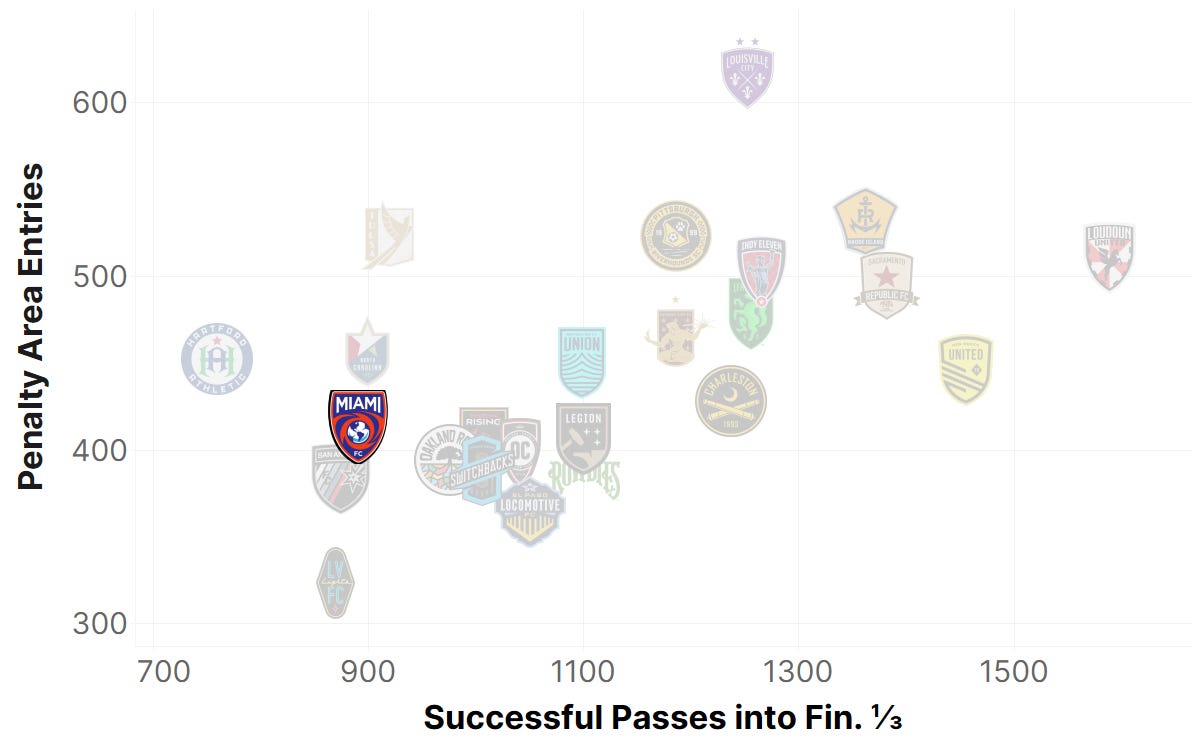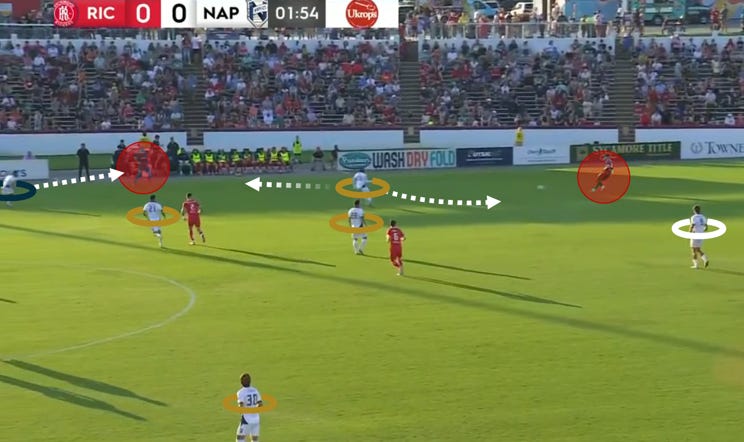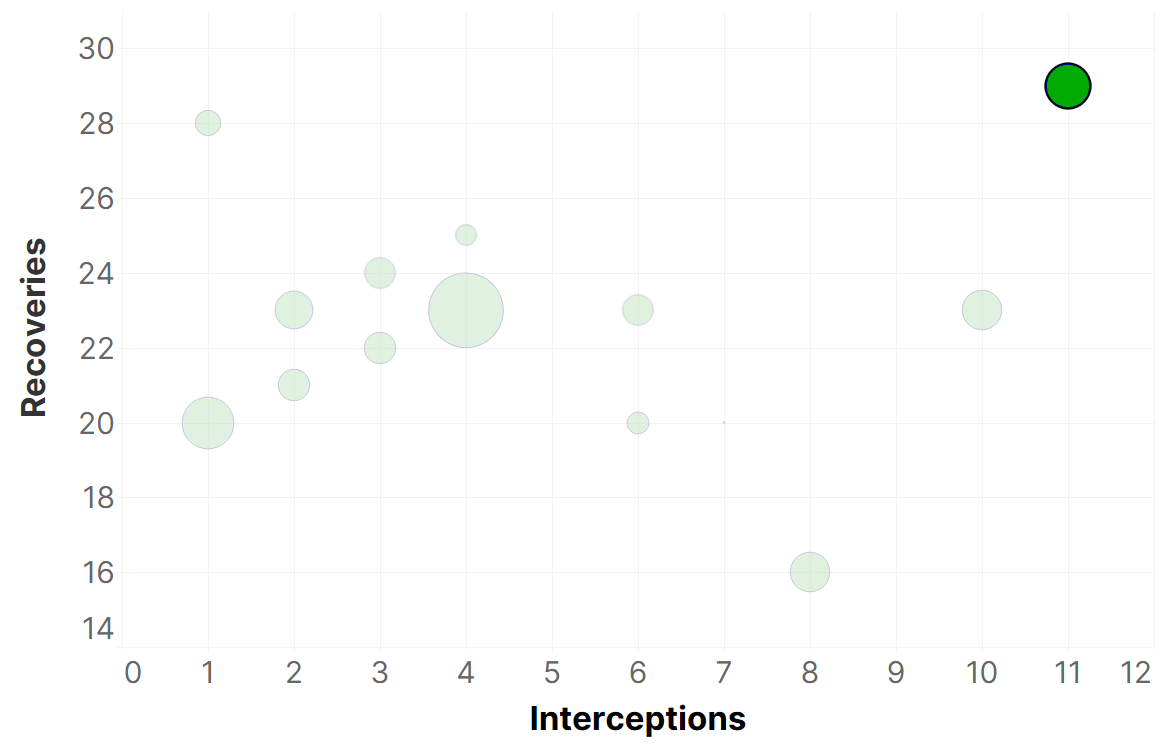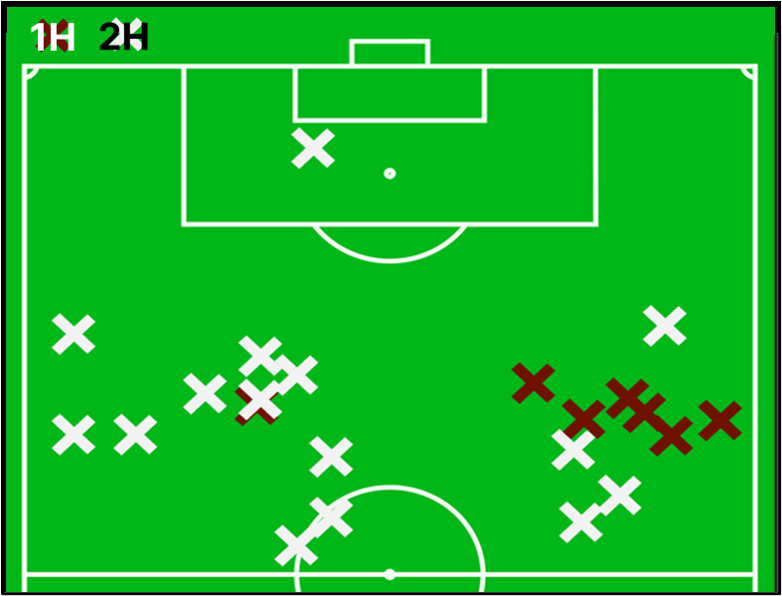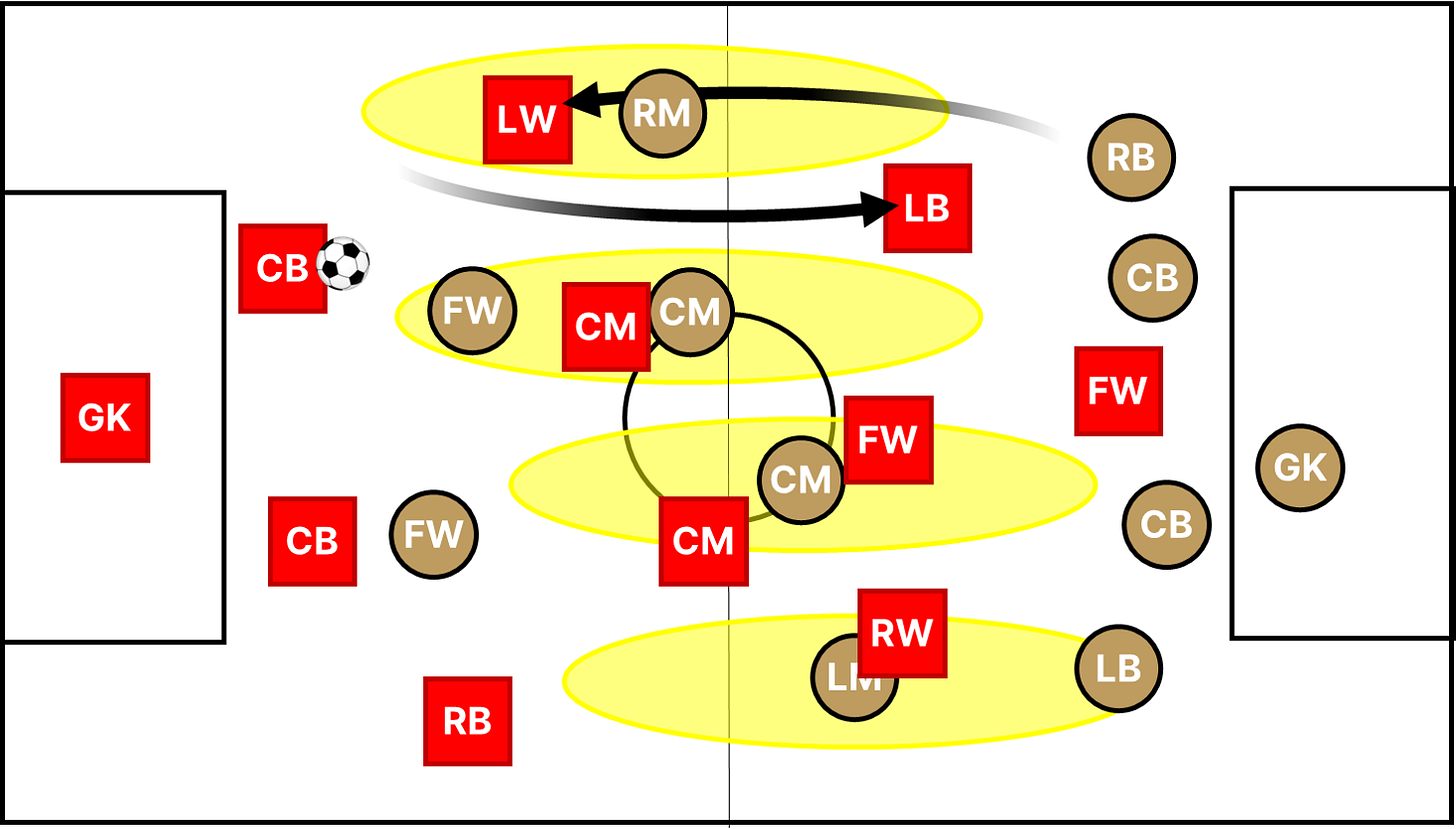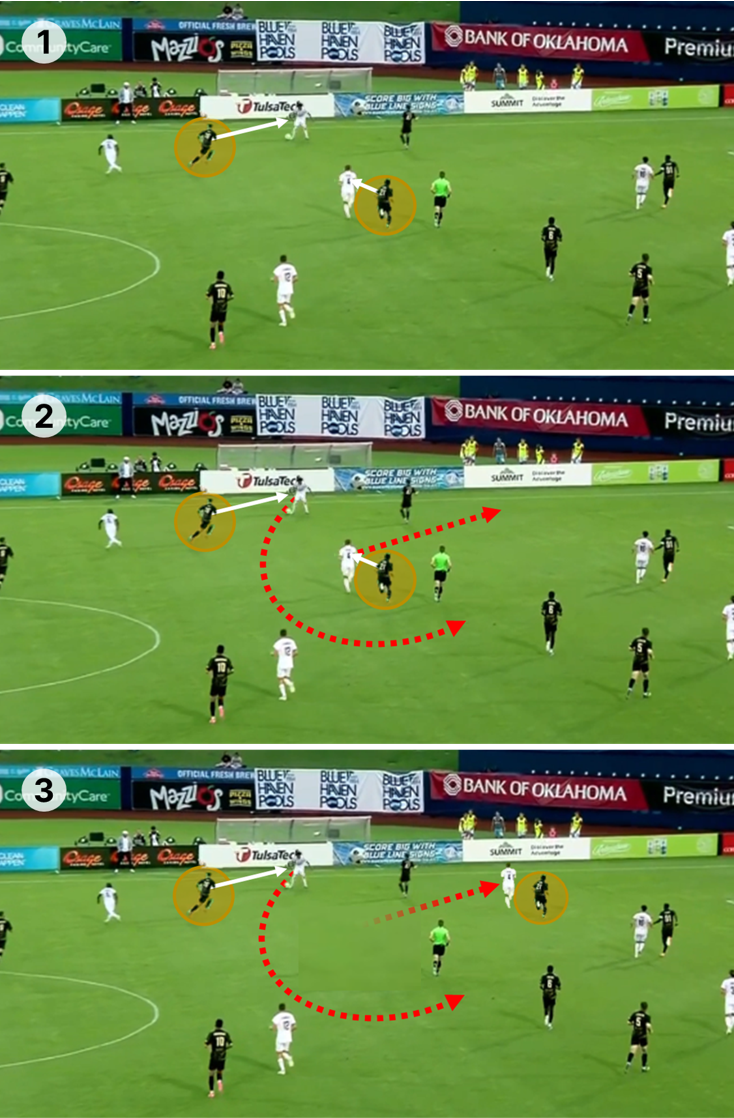The Back Four: Feelin' 22
Week 22 takeaways for Sacramento, Miami, and Naples, plus more from the USL Championship and USL League One
Welcome in to The Back Four!
Before we start, check out Backheeled for Quenzi Huerman, Louisville being awesome, and so much more from Week 22. You can also find This League! on the site for an audiovisual dive into the week that was.
Without further ado, let’s get to it.
Miami’s second-half struggles
For as much as Miami has improved this season, they’re still frustratingly unable to finish games. So far this season, they’ve dropped 13 points from winning positions, the second-most in the Championship.
How to manage with a lead is a question that beguiles many a coach, and Gaston Maddoni hasn’t found his answer yet. This season, Miami has scored just six goals in second halves on a meager 9.2 xG. While the club’s xG margin is actually better after the break, something changes in Miami’s disposition that kneecaps their attack and sets the table for late concessions.
What does Miami look like at the best of times? Here, you’re getting an example of their 4-4-2 at its most functional. Diego Mercado and Matias Romero control space in the midfield, and the reactions from the back line are timely. When opposing Pittsburgh tries to break lines, center back Daltyn Knutson immediately steps to pressure the ball.
This is ideal Miami. They’re never going to sell out in the high press, but they’re superbly structured at the second and third levels. Knutson and Bolu Akinyode both rank in the 80th percentile or better for takeaways and aerial win success, combining interventionism with stay-at-home confidence. Out wide, Jonathan Ricketts and Nico Cardona are asked to be defensive-minded and rarely overlap. Still, Ricketts has managed to put up top-half final-third entry numbers.
In the example, that back-end consistency leads to a takeaway and allows Sebastian Blanco to tuck inside in a transitional moment. Blanco is best in these situations where he can use his vision to put a scrambling opponent to the sword. While his pass here is deflected, the fact that the veteran Argentine is on the ball demands a reaction. Pittsburgh steps, and that allows space for Christian Vazquez – the winger opposite Blanco – to recover.
Once Miami finds a gap, and they’ve instantly got Lucas Melano and Francisco Bonfiglio charging upfield. The former can field Vazquez’s pass and force a stellar save. It’s the exact model that’s furnished the majority of Miami’s chances this season.
The problem? We’ve seen little else of note. Miami is excellent at these mid-block transitions, but they’re still a bottom-five team in terms of final-third access. The fact that technicians like Melano and Blanco are so efficient close to goal helps the cause, allowing Miami to punch above their weight in terms of box entries. Still, it’s difficult to keep pace in matches when you aren’t tilting the pitch via possession, especially in a system like Maddoni’s.
That “aggressive mid-block” posture softens later in games, to deleterious effect. The height of the defense doesn’t necessarily change, but Miami lets the action come to them. Miami has cleared the ball 267 times in second halves this year, 24% more than in the opening 45 minutes of their matches. The takeaways go away.
In that sense, Miami is halfway to success. We know they’ve got the blueprint, but they’re guilty of throwing it to the wind in order to play “prevent defense” late in matches. For now, the only thing that setup is preventing is Miami from making the playoffs.
On Naples’ defense
FC Naples lives and dies by their defensive integrity, and if a sixth-place position in the table is any indication, this club is doing more than just live – they’re thriving. As it stands, the expansion side is six points clear of the playoff cutline after a rock-solid win against Richmond in Week 22.
What’s so fascinating about Naples is their mixed statistical profile. This club has allowed the third-most final third entries in the division, yet they’re dead average in terms of shots allowed from inside the box. Squaring those contrasting numbers is simple: Naples is very, very good about maintaining structure in their own zone, even as their aggressive press aims to disrupt opponents high upfield.
Brecc Evans, Jake Dengler, and defensive midfielder Chris Heckenberg have rightly drawn plaudits for their contributions to that setup. That trio tends to stay at home as a resting base even as the fullbacks within Matt Poland’s 4-1-4-1 push high. It’s why Naples has put up the second-most clearances at one end and forced the third-greatest expected completion rate underperformance (-1.8%) everywhere else.
This weekend’s win was a neat encapsulation of Naples’ intelligent risk-taking. The Kickers actually got on the board first by playing around an elevated Max Glasser at fullback and thereby isolating Dengler, but Poland’s system ultimately limited Richmond to just 0.86 xG on the way to a 2-1 victory.
Consider the still here as a working example. Richmond’s right-sided center back is on the ball, with two center mids and wingback Simon Fitch potentially ready to receive. Note that Richmond ran a completely uncharacteristic 3-4-1-2ish shape in this match, deploying new patterns to create chances.
Naples didn’t let that happen, particularly in this example. Up the middle, there’s tight marking as Marc Torrellas and Luka Prpa hew close to their opposite numbers from the No. 8 spots. That duo contributed seven tackle attempts and contested 19 duels, constantly denying Richmond the right to central progression.
Meanwhile, left winger Andres Ferrin hedges up and hinges his hips toward the sideline in order to corral the ball carrier. Richmond’s pathway toward the central midfield is thus even further restricted, leaving only Fitch as a viable outlet. Still, he won’t be able to waltz through the defense. At the edge of the frame, fullback Julian Cisneros stands ready to close down.
Naples executed on this basic template again and again, and Richmond struggled to break through. Moments of individual inspiration from Maxi Schenfeld and Landon Johnson notwithstanding, Darren Sawatzky’s side lacked any sort of possessive foothold.
Naples wasn’t forced to do much transitional defending this weekend, but it’s another strength of their style. The expansion side has allowed the fourth-least fastbreak xG in League One thus far, partially due to the Evans-Dengler-Heckenberg axis but also because of a principled and communicative team character.
Admittedly, last weekend’s loss to Greenville in the Jagermeister Cup wasn’t Naples’ finest hour in a defensive sense. Indeed, Chevone Marsh got his winner by beating Cisneros on a break and slotting home a left-footed finish against an unsettled defense. Still, examples like you’re seeing above – those defined by wonderfully committed rotations – were far more common.
In the clip, Greenville creates a turnover out wide and immediately drives toward the center of the park. By the time the Triumph cross halfway, however, the entire Naples back line is in position, and Torrellas is putting pressure on the ball from the No. 6 spot.
Greenville keeps probing, moving wide of Torrellas and forcing Tomas Ritondale to step up from left back. As soon as Ritondale commits, two runners push behind him and potentially spoil what began as a slick Naples recovery.
Instead, Torrellas and winger Ian Garrett mark each of those runners, filling the vacant left pocket and denying Greenville their chance at penetration. The hosts recycle, and Naples is successfully able to settle things down.
It’s these sorts of sequences that make Matt Poland’s system work. We know Naples is threatening on the break when they can involve Karsen Henderlong, and we know how effective their press can be. None of that is possible unless you’re getting clean defensive rotations out of the 4-1-4-1.
Hartford on the rise
If you’re Brendan Burke, this chart ought to inspire confidence:
You’re seeing Hartford’s interceptions and recoveries in the first halves of matches, with each bubble sized by xG. Last Wednesday’s utterly dominant win against New Mexico – featuring 11 interceptions, 29 recoveries, and 1.2 xG – is called out at the extreme top end of the chart. All three numbers are top-three marks on the year for Hartford.
It’s the excellence in terms of active defensive intervention (i.e., interceptions) and more static ball-winning (recoveries) that stands out. Even in their best performances, this club hasn’t been able to thread the needle like they did against New Mexico – not only in their 5-1-3-1 press, but also in their ability to break like lightning toward the opposing net.
What’s remarkable about this broader moment for Hartford Athletic is how it feels like the logical end of an intentional process. Burke has gradually found balance, learning how to mix his midfield and involve players like Mamadou Dieng and Michee Ngalina within one sturdy team.
Excellence at center back is a given at this point, and when else have you been able to say that in club history? TJ Presthus would (maybe?) be my Rookie of the Year if such an award existed in the USL. Mostly used as a right-sided defender with Adrian Diz Pe hurt, Presthus has a 59% win rate versus a cumulative 53% amongst Hartford’s veteran center halves. Against New Mexico, he played on the left and looked utterly natural.
Ahead of that spine, the recent integration of Junior Moreira and Jonathan Jimenez has been key. Jimenez and Moreira have split time between the No. 10 and right mid spots depending on the matchup; against Rhode Island, Moreira was best used as a marker against the opposing No. 6, whereas he played the right pocket against New Mexico in order to deny lanes into Valentin Noel.
You get a sense for that Moreira-shifted shape here. It’s a 5-1-3-1 as a baseline, but Ngalina is allowed to hedge higher on the left while his teammate sinks against the ball movement toward Hartford’s right flank. In this case, Hartford absorbs pressure and stays compact enough to prevent penetration. When a window emerges, Ngalina is off to the races.
Even before the counter, notice how three midfielders jam into the same constricted section of the pitch. That side-to-side compaction was a constant, yet it never came at the expense of transition-centric offensive aims.
That a midfield composed of Marlon Hairston, Jimenez, and Moreira would come together so splendidly was far from a guarantee, yet they’ve been extremely organized in the last few weeks. There’s a real sense of understanding relative to the height of the back line, a real nous for picking the right moments to intervene and create tackle-and-go breakaways.
Ever since Brendan Burke took over in Connecticut, this club hasn’t felt complete. Defensive errors undercut any appetite for risk-taking at the attacking end; midfield inconsistency stopped Hartford from exerting control. This club obviously needs to keep up the level we saw against New Mexico for the changes to stick, but they’re third in the league for xG right now! There’s a legitimate chance that Hartford has figured it out.
Sacramento steps up
For about 45 minutes this weekend, Sacramento was in trouble. The Republic’s press didn’t bring enough heat, and opposing San Antonio found it far too easy to break lines into Jorge Hernandez’s feet. While they ended the first half level, something needed to change.
45 minutes later, Sacramento walked away 3-1 winners. The contrast between halves couldn’t have been starker, and while it’s obvious to point at star signing Khori Bennett as the difference-maker, the real improvement came without the ball. The hosts mustered just 0.16 xG in the second period, while the Republic took delight in closing to initiating ball carriers and battling in the midfield.
You get a sense for that glow-up in the graphic above, which maps Sacramento’s opposing-zone defensive attempts. Not every action here is successful, but the half-over-half difference is remarkable.
Neill Collins didn’t necessarily change his 5-2-3ish shape, but he allowed Russell Cicerone and Cristian Parano to drive at the opposing center backs with aplomb. In the first half, San Antonio completed 23 entry passes into the opposing zone through Mitchell Taintor and Alex Crognale on 85% accuracy. That count plummeted to 12 on 66% accuracy after halftime because of the inside-arcing, all-the-way-to-the-endline manner that Sacramento started to close down.
This season, the Republic lead the league in final-third takeaways, but the dirty secret of that statistic is that you aren’t getting more than five or so of those recoveries in a given game. What sets Sacramento apart is that they’re just as prodigious at forcing takeaways in the middle third – using high pressure to rush passes and enable midfield recoveries.
The San Antonio match was a masterclass in balanced 5-3-2ish defending, aimed at forcing rushed passes by the opposing center backs and creating either (1) wasteful long balls or (2) risky drives into the maw of the midfield.
You’re seeing that first scenario play out above, 78 minutes into the match. By this point, San Antonio had already been conditioned to avoid short build-out. You can see Rodrigo Lopez and Bennett ready to pounce if there’s a tap to one of the center backs, hence why goalkeeper Richard Sanchez elects to go long.
Already, Sacramento has won the battle. The Republic have the second-best aerial win rate (56%) in the USL; they’re trying to goad opponents into going long. That San Antonio plays into that strength is exactly what Collins hopes for.
At the back, Freddy Kleemann wins the initial header, knocking it toward halfway. There, substitute Luis Felipe wins a second header to push the ball into the attacking zone. A nailed-on starter in prior seasons, Luis Felipe has mostly been a super sub in 2025, but he’s learning how to maximize his impact in that role. Unlike other attacking minded subs, the Brazilian is a bludgeon. No USL midfielder is better at attacking the ball, making the No. 8 into a unique piece to throw at tiring defenses that wins 4.8 headers per 90 minutes.
As a result of the high pressure and back-end physicality, Parano can pick the ball up and drive at the defense. He and Lopez have a terrific sense of understanding, which buoys the rapid-fire tempo to put SAFC’s back four even further onto the back foot. This play doesn’t end in a shot, but it’s perfectly representative of the formula that earned Sacramento three points.
Pound-for-pound, the Republic are probably the West’s most talented team. Increasingly, we’re seeing what that actually means. Collins is picking the right moments to go full-bore, manipulating the league’s best press to take advantage of specific matchups. With Sacramento unbeaten since late June and up to second place, the Republic have a palpable sense of confidence that sets them apart from the vast majority of their peers.
Progress in defeat for Westchester
Westchester lost again. I am aware of that fact. Excepting the forfeit victory against Spokane, this club still has just one win since the start of April. That said, it’s hard to not to come away with at least some positives after Friday’s duel with Chattanooga.
Start with the shape. We saw Dave Carton break out a 3-4-3 last weekend in Detroit, but that match featured a heavily rotated lineup in a Jagermeister Cup setting with zero stakes. Last Friday was different. For all their struggles, Westchester could’ve pulled within two points of the playoff line with a win, making a return to that alternative formation all the more intriguing.
Possession is an empty number – particularly when you concede after six minutes! – but Westchester had 76% of it. Crucially, they looked handsome in terms of their off-ball movement. With Taimu Okiyoshi (60/65 as a passer) setting the table in the pivot and everyone else quite free to interchange, the hosts had six movers aiming to break the Red Wolves down.
This is a particularly slick sequence that beats the Red Wolves’ 5-4-1 as it tries to set a line of confrontation at halfway. JC Obregon drops in from striker to receive a pass, drawing a center back with him. Obregon’s only real outlet is Prince Saydee at the right sideline, and it’s easy to imagine this play fizzling out from there.
That isn’t the case. Instead, Dean Guezen has made a superb third-man run to essentially replace Obregon and keep the move alive. While Guezen doesn’t quite have the striker-like instinct to keep bending the defense and things ultimately slow when Obregon receives out wide, the principles here are stellar. It’s pass-and-move, find-and-replace soccer.
WSC wasn’t one note. When Chattanooga kept their back line too high, there was a real willingness for either Stephen Payne or Josh Drack to fly forward from wingback and stretch the defense. Rashid Tetteh, operating from the right side of the back three, was keen to pick those players out; a 24th minute half-chance for Payne on the end of a straight-line long ball was a prime example.
Westchester found it more difficult to work between the lines once they settled in the final third. Obregon’s tendency to show for touches, as useful as it was, didn’t always get that supporting movement in behind. Generally, Obregon sought most of his opportunities in the right halfspace, and Noah Powder – the left-sided No. 10 – was hesitant to move diagonally behind him. It seemed as if Saydee would’ve been better suited to the role, especially given that he ate up more than his share of the minutes on the left throughout his Championship tenure.
Jonathan Bolanos’ entrance as the right wingback in the second half improved the balance to a certain degree, allowing Westchester to get their equalizer. It also introduced a defensive risk, as when Chattanooga blasted a long restart over his head and beat a scrambling defense to re-take an insurmountable 2-1 edge.
Against a less organized team than the Red Wolves, WSC probably walks away with three points. As painful as yet another loss might be, this felt like a meaningful improvement for Westchester. How Carton manages things from here will be fascinating to see.
Loudoun’s defense might be cooked but I want to talk about their attack being sophisticated, thank you very much
So, yeah.
Loudoun is winless since mid-June and stuck in the Eastern muddle after a stellar start to 2025. You can point to plenty of factors behind that drop-off: Jacob Erlandson’s injury, briefer absences for Abdellatif Aboukoura and Zach Ryan, thin depth, Hugo Fauroux’s recent gaffes, etc.
As bad as things have been, Loudoun still looks like a recognizably classy unit in possession when they’ve got something close to their best XI available. The defensive errors are what they are, but it’s sequences like this that make me think a comeback is on the cards:
Pretty basic box entry sequence, right? Aboukoura doing his thing?
It’s deeper than that. Let’s back up and consider how Tulsa set up in this game.
Contrary to their usual back three, the hosts adopted a 4-4-2 with a sort of mixed marking scheme through the midfield. To my eye, Tulsa’s four midfielders essentially glommed to the nearest Loudoun player in front of them. Alex Dalou, the right-sided center mid, would typically address Tommy McCabe at the No. 6ish spot; transmogrified right winger Giordano Colli picked up Loudoun’s deepest left-sider.
That arrangement, while man in nature, essentially created four vertical lanes that could be manipulated, and Loudoun often tried to take advantage creating two-on-ones; I’ve mapped out such a scenario featuring Aboukoura and Kwame Awuah above.
In the clip, we’re seeing something a bit different. Loudoun is allowing their attackers to cut across lanes, using diagonal movement to test Tulsa’s rotations. It’s not just straight-line combination play as in the pitch graphic.
I’ve slowed down key frame where Tommy McCabe makes such a run, which you’re seeing here:
I’ve mapped Colli and Dalou’s marks above, followed by the runs that McCabe and Aboukoura are slated to make. Because McCabe draws the opposing marker toward the sideline, he naturally rips a gap in the Tulsa defense. That sets up Aboukoura to do what he does best: leverage a one-on-one matchup on his right foot to create danger.
In the clip, Aboukoura gets enough of an edge to connect on a give-and-go with striker Riley Bidois to get into the box. Earlier in the game, a low drop from Aboukoura created enough room between the lines for Awuah and Bidois to link for a go-ahead goal. Loudoun had the varied patterns they needed to manufacture chances and (in theory) earn a much-needed three points.
As it stands, the offensive joy is being undercut by defensive errors. Loudoun is now last in the USL with 1.56 xG against per match, falling victim to the same structural issues that doomed their playoff hopes in 2024. Most of those mistakes have been transitional in nature, again mirroring the shortcomings we’ve seen at Segra Field in recent years.
Help is on the way via loan, but how much can an offensive-minded right back like Omari Glasgow solve the problem? Time will tell.
For me, the slowdown truly began when Jacob Erlandson went down injured, and Loudoun hasn’t come close to re-creating his defensive composure. Maybe the Glasgow add and an ensuing central defensive shift from Keegan Tingey can do the job, but the jury is out.
It’s not going to take much for Loudoun to get back on track. We know how good the 2025 version of United can be, and the offensive tenets that anchor their excellence haven’t gone away. Even getting to the level of “decent” at the back would be transformative.
A chart!
Quick Hits
In other news this week…
Las Vegas has a coach! Get the scoop on Devin Rensing from Nicholas Murray, who talked to Ben Pirmann to find out about Las Vegas’ new manager. Then, come right back to this website where I’m back on my bullshit talking about coaching trees.
We talk a lot about Jearl Margaritha’s transfer to Belgium on the episode of This League! coming out tomorrow, so listen to that. For now, I’ll just note that we need more dribble-y guys in this league. Margaritha attempted 5.3 dribbles per 90 minutes with a success rate in excess of 50%, a skillset that’s so rare in the USL.
Mikkel Goling is an idiosyncratic representation of why One Knox is so fun. This weekend, he got their winning goal out of the midfield, but he also went 16/35 as a passer. On the year, he’s in the 90th percentile for duel attempts but still puts up 0.23 xGA per match. Lots of rookie midfielders are doing the job this year, and Goling is near the top of the class.
The two most underrated museums in New York: the Transit Museum in Brooklyn and the Museum of the Moving Image in Queens. The latter has a big exhibit on Mission: Impossible stunt work right now, and they’re pairing it with a Tom Cruise-centric screening series. Let me tell you, nothing hits like Top Gun: Maverick with a top-end sound system. I think my ears are still recovering, and I mean that as a compliment.
(Also, the Transit Museum is literally underground and has dozens of old train cars. It rocks.)

